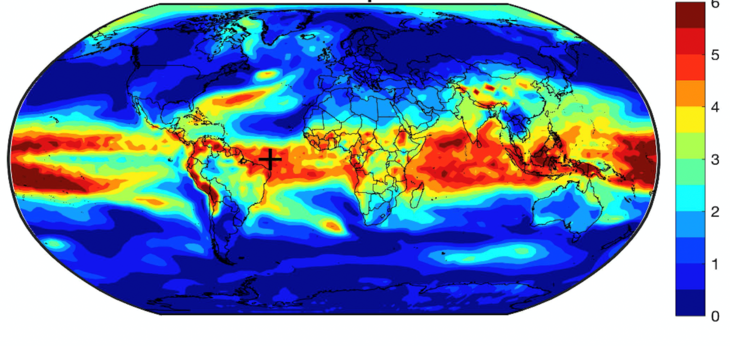Mar 5 2021
A group of climate scientists analyzing a wide range of climate modeling experiments have found that volcanic eruptions, and not natural variability, caused an evident 'Atlantic Multidecadal Oscillation,' a so-called cycle of warming considered to have taken place for about 40 to 60 years during the pre-industrial era.
 This map of the Earth shows the spacial pattern of temperature variance by percentage. The most variance is seen in the tropics with less at the poles. Image Credit: Daniel J. Brouillette, Penn State.
This map of the Earth shows the spacial pattern of temperature variance by percentage. The most variance is seen in the tropics with less at the poles. Image Credit: Daniel J. Brouillette, Penn State.
The findings of the study complement the earlier finding of the researchers that what had appeared as an 'AMO' during the period since industrialization is rather the outcome of a competition between constant human-induced warming from greenhouse gases and cooling from more time-variable industrial sulfur pollution.
It is somewhat ironic, I suppose. Two decades ago, we brought the AMO into the conversation, arguing that there was a long-term natural, internal climate oscillation centered in the North Atlantic based on the limited observations and simulations that were available then, and coining the term ‘AMO’.
Michael E. Mann, Distinguished Professor of Atmospheric Science and Director, Earth System Science Center, Pennsylvania State University
“Many other scientists ran with the concept, but now we’ve come full circle. My co-authors and I have shown that the AMO is very likely an artifact of climate change driven by human forcing in the modern era and natural forcing in pre-industrial times,” added Prof. Mann.
Earlier, the team demonstrated that the evident AMO cycle in the modern era was a product of industrialization-induced climate change, particularly the competition between warming in the last century from carbon pollution and a counterbalancing cooling factor—industrial sulfur pollution—which was strongest from the 1950s by the Clean Air Acts passed in the 1970s and 1980s.
However, they asked why is it still observed in pre-industrial records?
The conclusion of the study was reported in the Science journal on March 5th, 2021, and noted that the early signal was due to huge volcanic eruptions in the last few centuries that resulted in initial cooling and gradual recovery, with an average spacing of just more than half a century. The result denotes an irregular, approximately 60 year AMO-like oscillation.
Some hurricane scientists have claimed that the increase in Atlantic hurricanes in recent decades is due to the uptick of an internal AMO cycle. Our latest study appears to be the final nail in the coffin of that theory. What has in the past been attributed to an internal AMO oscillation is instead the result of external drivers, including human forcing during the industrial era and natural volcanic forcing during the pre-industrial era.
Michael E. Mann, Distinguished Professor of Atmospheric Science and Director, Earth System Science Center, Pennsylvania State University
The researchers analyzed the most advanced climate models both for preindustrial times in the last thousand years, where external factors like volcanic and solar drivers were used, and for unforced, 'control' simulations in which external drivers were not applied and any variations that occur are generated internally.
An analysis of the simulations for the short, 3 to 7 year El Niño Southern Oscillation (ENSO) cycles showed that these cycles took place in the models without the addition of forcing by volcanic activity, climate change, or anything else.
But when they searched for the AMO, it was not found in the unforced model and appeared only in modern times where climate change variables were used for forcing and in preindustrial times where volcanic eruptions were used for forcing.
The models do show intrinsic internal oscillations on a 3- to 7-year time scale characteristic of the established El Niño phenomenon, but nothing on the multi-decadal scale that would be the AMO. What we know is an oscillation like El Niño is real, but the AMO is not.
Byron A. Steinman, Associate Professor of Earth and Environmental Sciences, University of Minnesota Duluth
Steinman was also a part of the project. Mann proposed that although certain influential researchers continuously dismiss some climate change trends caused by a purported internal AMO climate cycle, the occurrence of such a cycle is not supported by even the best available scientific evidence.
Daniel J. Brouillette and Sonya K. Miller, both researchers in meteorology, were the other researchers from Penn State involved in this project. This study was financially supported, in part, by the National Science Foundation.
Journal Reference:
Mann, M. E., et al. (2021) Multidecadal climate oscillations during the past millennium driven by volcanic forcing. Science. doi.org/10.1126/science.abc5810.